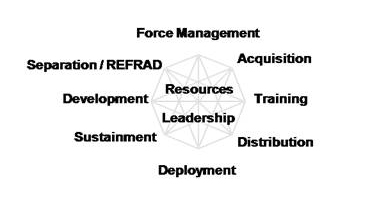Building Capacity in Iraq
Simply generating forces and getting them into the fight also falls short of a long-term solution; forces must be generated while the long-term capability to replenish those forces is developed using a systems of systems approach. This enduring capability requires an "enterprise mindset" to manage those forces and capabilities throughout the entire life cycle of force management, acquisition (including both personnel and equipment), training, distribution, deployment, sustainment, development, and separation and release from active duty (also including both personnel and equipment). Proper stewardship of these processes requires leader development and national-to-tactical resource management -- which requires a shift in the ministerial mindset in the aftermath of the Saddam regime.
The Multi-National Security Transition Command -- Iraq (MNSTC-I) has the mission "to assist the Iraqi Government in the development, organization, training, equipping, and sustaining of Iraqi Security Forces and Ministries capable of defeating terrorism and providing a stable environment where individual freedom, the rule of law, and free market economy can evolve and, in time, will contribute to Regional Security in the Gulf Region." This mission charges MNSTC-I with the responsibility to assist in the building of forces as well as assisting in the long-term sustainment and management of those forces by the ministries of Interior and Defense -- all taking place while engaged in the current counterinsurgency fight in Iraq.
To build this ministerial capacity, MNSTC-I uses an "enterprise approach" to track the systems and processes involved in the development and sustainment of trained and ready forces for the Iraqi Government. The enterprise approach is used to assist in the development of ministerial capability.

The enterprise "star chart" is very similar to the Army Organization Life Cycle Model (AOLCM) that is used in the Army War College in the "How the Army Runs" Senior Leader Reference Handbook, or HTAR. The AOLCM provides a holistic view of the interconnected systems and processes used to manage change on a continuing basis -- a situation that certainly exists today in Iraq.
The ministerial "star chart" shows that building and developing security forces in Iraq requires much more than building units and issuing equipment -- but also includes the hidden complexity that is involved in sustaining that capability. Focusing solely on building units and issuing equipment doesn't set the conditions for a meaningful transition -- it is only a transfer mentality.
Transition also includes developing a vision of the future while establishing clear goals and objectives to be met with specific milestones. To do this effectively there is a requirement to track not only the specific tasks associated with each of the enterprise elements, but to also track the effectiveness of those tasks within the entire enterprise. A 'balanced scorecard" that depicts the disparate tasks within each enterprise element -- and then measures whether or not the end state -- "Iraqi Security Forces and Ministries capable of defeating terrorism and providing a stable environment where individual freedom, the rule of law, and free market economy can evolve and, in time, will contribute to Regional Security in the Gulf Region" is being achieved.
This entire "systems of systems" or enterprise approach represents a change in the methodology to security transition -- creating a transition that will create enduring capability, rather than focusing merely on the short-term mission of generating forces.
Dr. Jack D. Kem is the Chief of the Combined Arms Center (CAC) Commander's Initiatives Group (CIG), Fort Leavenworth, KS. As the CIG Chief, Dr. Kem assists the CAC Commander by developing ideas and initiatives, conducting strategic planning, and conducting independent and unbiased analysis of the CAC Commander' areas of interest. Dr. Kem also hold a concurrent appointment as a Supervisory Professor in the Department of Joint, Interagency, and Multinational Operations in the US Army Command and General Staff College. Dr. Kem is currently on temporary assignment with MNSTC-I.


